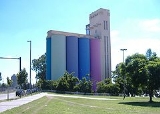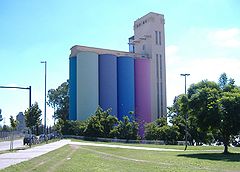
Museum of Contemporary Art of Rosario
Encyclopedia

Spanish language
Spanish , also known as Castilian , is a Romance language in the Ibero-Romance group that evolved from several languages and dialects in central-northern Iberia around the 9th century and gradually spread with the expansion of the Kingdom of Castile into central and southern Iberia during the...
, Museo de Arte Contemporáneo de Rosario, often abbreviated MACRo) is an annex to the Juan B. Castagnino Fine Arts Museum
Juan B. Castagnino Fine Arts Museum
The Juan B. Castagnino Fine Arts Museum is an art museum in the city of Rosario, , considered the most important of the interior of the country and the second in national terms. It is administered by the municipal government...
that is devoted to contemporary art
Contemporary art
Contemporary art can be defined variously as art produced at this present point in time or art produced since World War II. The definition of the word contemporary would support the first view, but museums of contemporary art commonly define their collections as consisting of art produced...
, located in the city of Rosario
Rosario
Rosario is the largest city in the province of Santa Fe, Argentina. It is located northwest of Buenos Aires, on the western shore of the Paraná River and has 1,159,004 residents as of the ....
, .
The MACRo lies beside the Paraná River
Paraná River
The Paraná River is a river in south Central South America, running through Brazil, Paraguay and Argentina for some . It is second in length only to the Amazon River among South American rivers. The name Paraná is an abbreviation of the phrase "para rehe onáva", which comes from the Tupi language...
, at the northern end of Oroño Boulevard
Oroño Boulevard
Oroño Boulevard is a street in Rosario, Santa Fe Province, Argentina. It is a two-way boulevard that runs north–south through the center-east of the city, from the coastal avenue by the Paraná River to the southern limit of the urbanized area...
, on the Estanislao López Riverfront Avenue. It was opened to the public on November 19, 2004.
The works took advantage of the Davis Silos (an abandoned grain
GRAIN
GRAIN is a small international non-profit organisation that works to support small farmers and social movements in their struggles for community-controlled and biodiversity-based food systems. Our support takes the form of independent research and analysis, networking at local, regional and...
silo
Storage silo
A silo is a structure for storing bulk materials. Silos are used in agriculture to store grain or fermented feed known as silage. Silos are more commonly used for bulk storage of grain, coal, cement, carbon black, woodchips, food products and sawdust. Three types of silos are in widespread use...
complex, formerly part of Rosario's port facilities
Port of Rosario
The Port of Rosario is an inland port and a major goods-shipping center of Argentina, located in the city of Rosario, province of Santa Fe, on the right-hand shore of the Paraná River, about 550 km upstream from the Atlantic Ocean.-Overview:...
, now moved south). The bulk of the building consists of eight large concrete
Concrete
Concrete is a composite construction material, composed of cement and other cementitious materials such as fly ash and slag cement, aggregate , water and chemical admixtures.The word concrete comes from the Latin word...
silos, painted in different colors, with a diameter of 7.5 metres. The idea, according to the official site of the museum, was "to integrally preserve the building, exalting the unique features of concrete, stressing austerity as a value." There is a glass elevator outside the building, for a view of the river scenery and the nearby islands.
The actual museum exhibition is located on an attached building that formerly housed the administrative offices. It has ten floors, for a total area of 970 m² (10,400 ft²), and as of November 2005 maintained a collection of 300 art works by 220 different artists, including Lucio Fontana
Lucio Fontana
Lucio Fontana was an Italian painter, sculptor and theorist of Argentine birth. He was mostly known as the founder of Spatialism and his ties to Arte Povera.-Early life:...
and Antonio Berni
Antonio Berni
Delesio Antonio Berni was a figurative artist, born in Rosario, province of Santa Fe, Argentina. He worked as a painter, an illustrator and an engraver. His father, Napoleón Berni, was an immigrant tailor from Italy...
.

